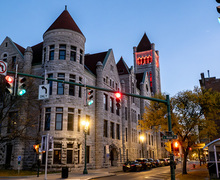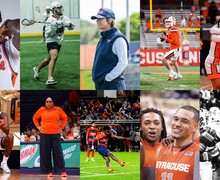After 2 seasons off, Tiana Mangakahia has the ability to be the nation’s best point guard
Codie Yan | Staff Photographer
Tiana Mangakahia, after two years of not playing, is putting herself in position to be the best point guard in the country.
Tiana Mangakahia moved from Meadowbrook, Australia, to Hutchinson, Kansas, to play basketball.
But there was a problem.
Mangakahia had signed an amateur contract while playing in Australia, something she said wasn’t “anything big.” Still, it threw her eligibility into question. The head coach at Hutchinson Community College, John Ontejs, said she wasn’t eligible according to NJCAA rules.
Ontejs and Athletic Director Josh Gooch were going through Mangakahia’s paperwork when they discovered the issue. The two met with Mangakahia and broke the news. She’d have to sit for two years.
“That was probably the harder year, my second year,” Mangakahia said. “Just because I had to do it all over again.”
Still, Mangakahia persisted, and now, after two of the hardest years of her life, she is the starting point guard for Syracuse (22-7, 10-6 Atlantic Coast). Mangakahia’s transcendent court vision and passing drew D-I eyes despite her sitting on the bench for two years. It’s those traits, the essence of a pure point guard, that made Mangakahia the ACC single-season assists record-holder. And it’s those traits that have coaches at SU saying Mangakahia, a junior-college transfer, has the foundation to become the best point guard in the country.
“That’s what your goal should be,” said SU assistant coach and former WNBA guard Tammi Reiss. “That’s what you’re working towards. She has the talent, she has the skill level. It’s those intangible things she needs to grow her game.”
No one, not even Mangakahia, is quite sure where she gets her court vision from.
Mangakahia remembers being good at basketball as a child, playing competitive pick-up games with her older brothers. She thinks that helped her vision and passing, but she’s not sure. She also remembers Christmas-time pick-up games with extended family, where her uncle displayed passing that wowed Mangakahia. She joked that maybe it’s genetic.
“Just natural instinct, I guess,” she said.

Codie Yan | Staff Photographer
She parlayed her passing ability into a chance to train at the Australian Institute of Sport, the nation’s sports development academy, Mangakahia said. During her time there, Mangakahia practiced on the women’s team while the likes of current NBA players Ben Simmons and Dante Exum played for the men’s side.
After two years at AIS, Mangakahia played point guard for the Australian under-19 national team, leading her country to a bronze finish at the 2013 FIBA World Championships in Lithuania. Then, she returned home from Eastern Europe, playing a season with the Townsville Fire in the Australian Women’s National Basketball League. Eventually, she moved on to Hutchinson, following her friend and current professional basketball player, Kalani Purcell.
She couldn’t play in games, but Mangakahia practiced with the team, leading the scout team and challenging other players in practice, Ontejs said. There were days she struggled, but Ontejs and his staff pushed her just like any other player.
“When we got her here and recognized and realized the situation,” Ontejs said, “we weren’t going to bail on it.”
Come gamedays, Mangakahia took on the role of player-coach. From the bench, she focused on reading the defense, picking up little nuances and developing ways to exploit them. When teammates came off the floor, Ontejs said, Mangakahia almost always had a tip or bit of advice for someone to help expose a defense.
Even though she wasn’t playing, she still directed her teammates. But simply showing some leadership and coaching prowess wasn’t enough to reel in a D-I offer. Luckily for Mangakahia, junior colleges play in preseason jamborees, essentially weekend tournaments packed with scrimmages, that pose no eligibility issues.
The jamborees and her coaches’ advocacy focused Syracuse’s attention on Mangakahia, who finished her junior college career ranked the No. 1 junior-college recruit by espnW HoopGurlz.
“It made me go to bed very comfortably at night knowing you have a very good point guard,” Reiss said.
And so, despite not playing for two years and having potential eligibility problems, the offers rolled in. Oklahoma State and Nebraska were in the running, but Syracuse always stood out to Mangakahia. Partially because of the play style and due to the coaching staff, but also because SU head coach Quentin Hillsman promised her that if she got her paperwork in order, they would do everything possible to get her eligible.

Kevin Camelo | Digital Design Editor
Mangakahia needed a litany of documents due to her international and junior-college status. That included records from Hutchinson all the way to under-nine basketball registration, which no one in Australia keeps, Mangakahia said. Her parents managed to hunt down all the documents, though, and after Syracuse’s compliance office looked everything over and deemed it a possibility, Reiss said, it was time to go to the NCAA for an eligibility waiver.
A waiting game ensued, and the unknown filled Mangakahia’s mind. The main concern surrounded how many years of eligibility she’d get. Eventually, in the summer of 2017, Mangakahia sat in the Stevenson Educational Center on SU’s South Campus. The team’s director of program management and development, Cedric Solice, walked by.
“You know you got three years of eligibility?” Solice asked.
After two years of waiting, Mangakahia could finally play. At Hutchinson, she couldn’t be a player, so she learned to lead from the side. At Syracuse, she’s had to focus on playing, refining her skills with every game.
Mangakahia’s vision allows her to make unexpected plays. Sometimes her own teammates are caught off guard. Against Pittsburgh on Feb. 19, Mangakahia hit Gabrielle Cooper going to the rim, but Cooper missed the layup. After the play, Mangakahia said, Cooper apologized, saying she expected Mangakahia to shoot.
But teammates are adjusting. With just less than two minutes remaining in the first quarter against Duke on Feb. 15, Mangakahia came off a ball screen to her right and whipped a pass to Isis Young in the corner for a wide open 3. About five seconds before the screen, the two made eye contact.
“She’ll make a decision, go, and then she’ll distribute the basketball,” Reiss said.
Earlier in the season, after No. 4 Louisville came to the Carrier Dome and scraped by Syracuse, 84-77, UofL head coach Jeff Walz heaped praise on SU’s point guard.
“If you’re a basketball fan in this city and you don’t come out to watch her, shame on you,” Walz said postgame. “I have no idea why there’s not 5,000 people, 6,000 in this place watching that kid play.”

Codie Yan | Staff Photographer
So far, Mangakahia’s skill has been enough to take SU to a 22-7 record and has the Orange feeling comfortable about its NCAA tournament chances, but Reiss wants more. She wants Mangakahia to be both a player and a leader.
As a point guard, Mangakahia is expected to take charge, something she hasn’t done much this year. New to the team and admittedly not that vocal, Mangakahia acknowledged that being the leader isn’t easy. Reiss said she’s gotten better, even claiming Mangakahia is a top-tier point guard in the country.
“That’s a point guard,” Reiss said. “That kid reminds me of Dawn Staley and Ticha Penicheiro as far as the vision, the passing with the swagger to her game. A real point guard, a pure point guard.”
But, Reiss said, there are things Mangakahia needs to improve to ascend from good to the best point guard in the country: decision making, 3-point shooting, athleticism and leadership.
The shooting, Reiss said, opens up the entire offensive game. Reiss cited Brittney Sykes’ 3-point shot as the thing that made her unguardable, and said the same applies to Mangakahia.
She also needs to emphasize time in the weight room and dedicate herself to conditioning, Reiss said. Early in the season, Mangakahia held her hands on her sides, gasping for breath as her face flushed after sprinting up and down the court in Hillsman’s high-octane system. As the season has progressed, she’s gotten back into game shape, she said.
“She has to become an unbelievable athlete,” Reiss said. “‘I can play 40 minutes, I can go balls to the wall, I’m strong, I’m fast, I’m agile, I’m quick.’”
The decision-making comes with time and film study. It’s a tedious but necessary process. Each day, the coaching staff tries to impress upon Mangakahia the importance of making the right play, not the flashy one. Mangakahia persevered at Hutchinson, and she seems destined to prevail at Syracuse.
When smart play, shooting and athleticism all come together, Reiss said, is when Mangakahia will be the leader, not just because she’s the point guard, but because she’s the best player on the floor in every game she plays.
“When she leads by example,” Reiss said, “when no one can beat her in anything we do, now you follow her.”
Published on February 27, 2018 at 10:40 pm
Contact Andrew: aegraham@syr.edu | @A_E_Graham





